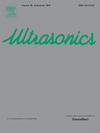基于康托选择模式的有限发射数的超快超声成像。
IF 4.1
2区 物理与天体物理
Q1 ACOUSTICS
引用次数: 0
摘要
在相干平面波合成(CPWC)中,帧率的提高是一个具有挑战性的问题。随着发射次数的减少,帧率将会增加。然而,这种改进是以重建图像的质量下降为代价的。为了解决图像质量和帧率之间的折衷问题,本文提出了一种基于康托尔选择模式的新方法。在该方法中,在特定的角度间隔内稀疏选择包含有限数量发射的集(Cantor集)。在这个阶段,选定的排放物数量大大减少,因此,它在实际应用中是有希望的。此外,为了防止图像质量下降,我们建议使用多信号分类(MUSIC)算法的输出作为加权因子。MUSIC算法适用于处理稀疏数据集,该算法从康托尔集构建与大量均匀选择的发射相关的二阶数据(称为Co-emission),从而提高了生成图像的质量。评价表明,与延迟和和(DAS)方法相比,该方法提高了图像质量,其中使用了康托尔和共同发射集包含的发射。特别是,对于实验对比幻影,通过使用8个发射点,与使用Cantor集(即8)和Co-emission集(即27)中包含的发射数相对应的DAS相比,该方法的分辨率分别提高了50%和45.45%,同时使散斑保存度量与其他提到的情况相当。此外,与使用Cantor和Co-emission集合对应的DAS相比,使用该方法在体内数据集的对比度分别提高了46.49%和0.63%。本文章由计算机程序翻译,如有差异,请以英文原文为准。
Ultrafast ultrasound imaging with a limited number of emissions based on Cantor selection pattern
In coherent plane-wave compounding (CPWC), frame rate improvement is challenging. As the number of emissions reduces, the frame rate will increase. However, this improvement is at the cost of quality deterioration of the reconstructed image. To deal with the compromise between image quality and frame rate, we propose a novel method based on the Cantor selection pattern in this paper. In the proposed method, a set that includes a limited number of emissions (Cantor set) is sparsely selected within a specific angular interval. At this stage, the number of selected emissions is considerably reduced, and consequently, it can be promising in practical applications. Also, to prevent image quality degradation, we propose to use the multiple signal classification (MUSIC) algorithm’s output as a weighting factor. In the MUSIC algorithm, which is suitable for processing the sparse dataset, the second-order data associated with a larger number of uniformly selected emissions (called Co-emission) is constructed from the Cantor set, leading to quality improvement of the resulting image. Evaluations demonstrate that the proposed method improves the quality of the image in comparison with the delay-and-sum (DAS) method in which the emissions included in Cantor and Co-emission sets are used. In particular, for the experimental contrast phantom, and by using eight emissions, the proposed method leads to 50% and 45.45% resolution improvement compared to DAS corresponding to using the emission numbers included in Cantor set (i.e., 8) and Co-emission set (i.e., 27), respectively, while keeping the speckle preservation metric comparable to the other mentioned cases. Also, by using the proposed method, 46.49% and 0.63% contrast ratio improvement is achieved compared to DAS corresponding to using the emissions included in Cantor and Co-emission sets, respectively, for in-vivo dataset.
求助全文
通过发布文献求助,成功后即可免费获取论文全文。
去求助
来源期刊

Ultrasonics
医学-核医学
CiteScore
7.60
自引率
19.00%
发文量
186
审稿时长
3.9 months
期刊介绍:
Ultrasonics is the only internationally established journal which covers the entire field of ultrasound research and technology and all its many applications. Ultrasonics contains a variety of sections to keep readers fully informed and up-to-date on the whole spectrum of research and development throughout the world. Ultrasonics publishes papers of exceptional quality and of relevance to both academia and industry. Manuscripts in which ultrasonics is a central issue and not simply an incidental tool or minor issue, are welcomed.
As well as top quality original research papers and review articles by world renowned experts, Ultrasonics also regularly features short communications, a calendar of forthcoming events and special issues dedicated to topical subjects.
 求助内容:
求助内容: 应助结果提醒方式:
应助结果提醒方式:


